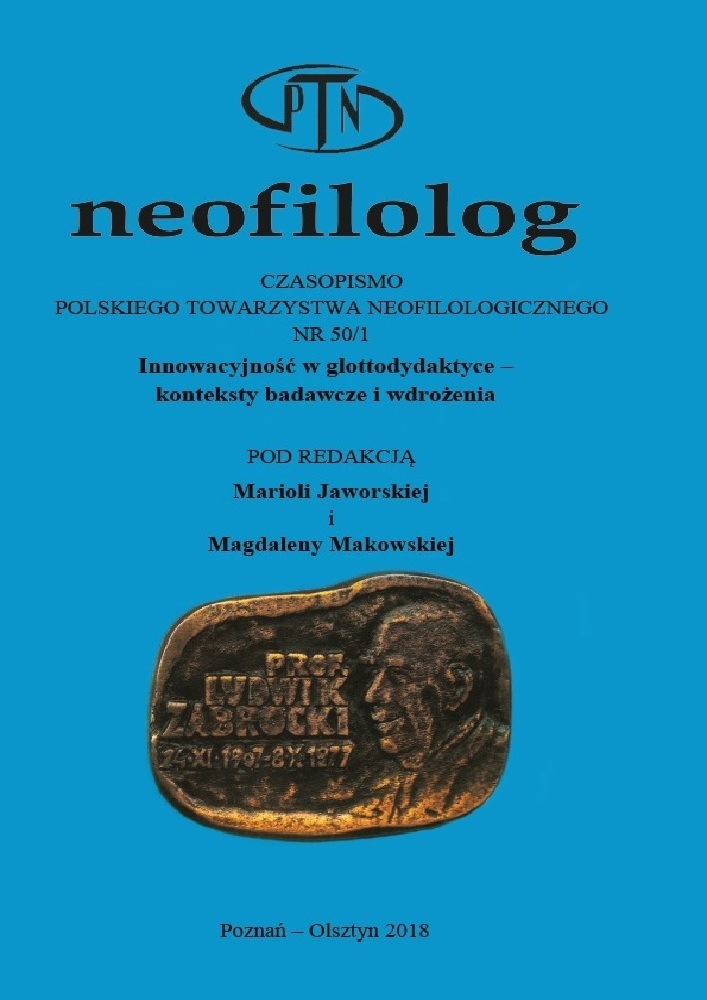Abstrakt
The subject of this article is the use of reformulation, the instrument of language acquisition research, in studies on language teaching and learning. Incorporating reformulation into the methodological repertoire of language education research requires a clear definition of differences in the subject-matter and in objectives of research between the two disciplines, in order to clearly capture the potential and limitations of this tool. This article will consider the innovative potential of reformulation at both the research level and the didactic level, at various stages of development of communicative competencies in a foreign language.Bibliografia
Bowerman M. (2003), Rola predyspozycji kognitywnych w przyswajaniu systemu semantycznego (w) Dąbrowska E., Kubiński W. (red.), Akwizycja języka w świetle językoznawstwa kognitywnego. Kraków: Universitas, s. 254-313.
Canale M. (1983), From communicative competence to communicative language pedagogy (w) Richards J.C., Schmidt R.W. (red.), Language and communication. London – New York: Longman, s. 2-27.
Chenu F., Jisa H. (2009), Reviewing some similarities and differences in L1and L2 lexical development (w) Acquisition et interaction en langue étrangère. Online: http://aile.revues.org/4506 [DW 07.01.2018].
Dakowska M. (2001), Psycholingwistyczne podstawy dydaktyki języków obcych. Warszawa: Wydawnictwo Naukowe PWN.
Dąbrowska E., Kubiński W. (red.) (2003), Akwizycja języka w świetle językoznawstwa kognitywnego. Kraków: Universitas.
Harris Z.S. (2007) [1988], La langue et l’information. Paris: Cellule de Recherche en Linguistique.
Karpińska-Szaj K., Wojciechowska B. (2015), La performance morphosyntaxique dans les tâches de reformulation écrite. Cas d’étudiants débutants de FLE (w) „Neofilolog”, nr 44/1, s. 73-90.
Karpińska-Szaj K. (2015), Przygotowanie do pracy z uczniami o specjalnych potrzebach edukacyjnych: językowe narzędzia diagnostyczne w praktyce nauczycielskiej (w) „Neofilolog”, nr 45/2, s. 187-202.
Konderak P. (2016), Akwizycja (przyswajanie) języka (w) Bremer J. (red.), Przewodnik po kognitywistyce. Kraków: Wydawnictwo WAM, s. 526-549.
Lahire B. (1992), L'inégalité devant la culture écrite scolaire: le cas de l'expression écrite à l'école primaire (w) „Sociétés contemporaines”, nr 11, s. 171-191.
Langacker R.W. (2009), Gramatyka kognitywna. Wprowadzenie. Kraków: Universitas.
Le Cunff C. (2008), Reformuler pour apprendre, apprendre à reformuler: usages didactiques de la reformulation en français langue maternelle (w) Schuwer M., Le Bot M.-C., Richard E. (red.), Pragmatique de la reformulation, types de discours interactions didactiques. Rennes: P.U.R., s. 203-219.
Martinot C. (2012), De la reformulation en langue naturelle, vers son exploitation pédagogique en langue étrangère: pour une optimisation des stratégies d’apprentissage (w) Karpińska-Szaj K., Zając J. (red.), Autour de la compétence d’apprentissage de langues : gestion des ressources métacognitives et cognitives. „Synergies-Pologne”, nr 9, s. 63-76.
Martinot C., Marque-Pucheu Ch., Gerolimich S. (red.) (2016), Perspectives harrissiennes. Paris: Cellule de Recherche en Linguistique.
Martinot C., Bošnjak B.T., Gerolimich S., Paprocka-Piotrowska U. (red.) (2018), Reformulation et acquisition de la complexité linguistique. Perspective interlangue. Londyn: ISTE, Collection Sciences Cognitives.
Pawlak M. (2011), Text reconstruction activities and teaching language forms (w) Majer J., Salski Ł. (red.), FLOW. Foreign Language Opportunities in Writing. Łódź: Łódź University Press, s. 21-40.
Schmidt R. (1990), The role of consciousness in Second Language Learning (w) „Applied Linguistics”, nr 11/2, s. 129-158.
Schmidt R., Frota S. (1986), Developing basic conversational ability in a second language. A case study of an adult learner of Portuguese (w) Day R. (red.), Talking to learn: Conversation in second language acquisition. Rowley, MA: Newbury House, s. 237-326.
Slobin D.I. (1985), Crosslinguistic Evidence for the Language-Making Capacity (w) Slobin D.I. (red.), The Crosslinguistic Study of Language Acquisition, t. 2: Theoretical Issues. Hillsdale, NJ: Lawrence Erlbaum, s. 1157-1249.
Sopata A. (2013), Wczesna wielojęzyczność: rola wieku rozpoczęcia akwizycji języka (w) „Lingwistyka Stosowana/Applied Linguistics/Angewandte Linguistik”, nr 7, s. 135-144.
Swain M. (1985), Communicative competence: Some roles of comprehensible input and comprehensible output in its development (w) Gass S.M., Madden C.G. (red.), Input in second language acquisition. Rowley, MA: Newbury House, s. 235-253.
Swain M. (1995), Three functions of output in second language learning (w) Cook G., Seidlhofer B. (red.), Principle and practice in applied linguistics. Oxford: Oxford University Press, s. 125-144.
Swain M., Lapkin S. (2002), Talking it through: two French immersion learners’ response to reformulation (w) „International Journal of Educational Research”, nr 37, s. 285-304.
Tabakowska E. (2016), Językoznawstwo kognitywne – geneza, kierunki i perspektywy (w) Bremer J. (red.), Przewodnik po kognitywistyce. Kraków: Wydawnictwo WAM. s. 79-120.
Thornbury S. (1997), Reformulation and reconstruction: Tasks that promote ‘noticing’ (w) „ELT Journal”, nr 51, s. 326-335.
Tomasello M. (2003), Społeczno-pragmatyczna teoria uczenia się słów (w) Dąbrowska E., Kubiński W. (red.), Akwizycja języka w świetle językoznawstwa kognitywnego. Kraków: Universitas, s. 211-225.
Tomasello M. (2015) [2009], Dlaczego współpracujemy? Warszawa: Copernicus Center Press.
Widła H. (red.) (2010), Glottodydaktyka jako nauka. „Neofilolog” 34.
Wygotski L. (1989) [1934], Myślenie i mowa. Warszawa: Wydawnictwo PWN.
Licencja
Prawa autorskie (c) 2018 Katarzyna Karpińska-Szaj, Bernadeta Wojciechowska

Utwór dostępny jest na licencji Creative Commons Uznanie autorstwa – Bez utworów zależnych 4.0 Międzynarodowe.
Przedstawiany utwór (artykuł) upubliczniany jest na podstawie umowy z autorem i na licencji Creative Commons Attribution-NoDerivatives 4.0 International (CC BY-ND 4.0).
Użytkownicy mają obowiązek podania wraz z rozpowszechnionym utworem, informacji o autorstwie, tytule, źródle (odnośniki do oryginalnego utworu, DOI) oraz samej licencji;
- bez tworzenia utworów zależnych,
- utwór musi być zachowany w oryginalnej postaci.
Uniwersytet im. Adama Mickiewicza w Poznaniu zachowuje prawo do czasopisma jako całości (układ, forma graficzna, tytuł, projekt okładki, logo itp.).
